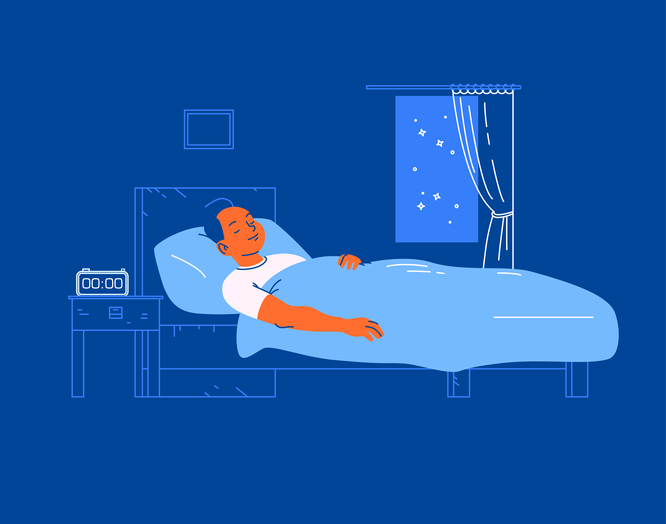Can’t Sleep? Here Are Some Surprising Strategies That Work
The pandemic has given us a year of lousy sleep and insomnia. Here’s what to do.
How are you sleeping?
After one year of a pandemic—and a lot of disturbed slumber—it’s clear that our usual sleep strategies aren’t working. Scientists say many of the things we do to chase sleep are actually hurting us, and recommend a counterintuitive approach instead: Stay in bed for less time, not more.
I’ve been battling insomnia lately. I know I’m not alone. Approximately 40% of the population has had sleep problems during the pandemic, according to a meta-analysis of 44 studies from 13 countries published online in February in the Journal of Clinical Sleep Medicine.
The pandemic has been a significant source of stress and worry. Our daily routines have been disrupted, affecting our circadian rhythms. And social isolation has led to mental-health problems such as depression and anxiety.
“Our brains have to feel like the world is safe and secure to be able to fall asleep,” says Wendy Troxel, a clinical psychologist, certified behavioural sleep medicine specialist and senior behavioral and social scientist at Rand Corp. “Sleep is a vulnerable state.”
We all know we’re supposed to have good sleep hygiene—keep a consistent schedule; use the bed for sleep and sex only; avoid alcohol, caffeine and bright lights before bed and practice other healthy sleep habits. This is important. But the American Academy of Sleep Medicine recently declared it’s not enough to solve chronic insomnia. In an article published online in February in the Journal of Clinical Sleep Medicine, it recommended a series of treatments collectively known as cognitive behavioural therapy for insomnia, or CBT-I.
Unlike run-of-the-mill sleeping problems, insomnia is a clinical disorder. We have insomnia when we have difficulty falling or staying in sleep three or more times a week, and this lasts a month or longer, leading to daytime consequences, such as fatigue, mood changes or difficulty concentrating. Sleep experts believe insomnia is triggered in part by the fear and anxiety we have about not sleeping.
The brains of people with insomnia act differently than the brains of people who are sleeping well, according to Daniel J. Buysse, a professor of psychiatry and sleep medicine specialist at the University of Pittsburgh School of Medicine. Dr Buysse has conducted PET scans of people who sleep normally and people with insomnia. In people with insomnia, parts of the brain involved with self-reflection and monitoring the environment show higher levels of activity during sleep compared with normal sleepers.
Ironically, insomnia is also driven by the things we do to try to solve it, experts say. We start to chase sleep—waking up later, taking naps, going to bed too early. This diminishes our sleep drive, which is our body’s need for sleep. It makes it harder to sleep when we’re supposed to. And it creates a vicious cycle: More time in bed means more opportunity for frustration and failure. Before long, we’ve taught our brain to associate our bed with the negative emotions we feel lying there.
“It’s Pavlovian,” says Philip Cheng, a clinical psychologist and sleep researcher at the Henry Ford Sleep Disorders and Research Center. “If you spend a lot of time in bed worried and frustrated and miserable, in time your brain learns that your bed is a place to do all of these things but sleep.”
CBT-I focuses on breaking this loop by helping us change the thoughts and behaviours that are counterproductive. Research shows it may have lasting effects—not just fixing our sleep problems in the present but helping us form a sort of sleep resilience. A study conducted by Dr Cheng and colleagues and published online in November in the journal Sleep found that people who received CBT-I years ago have been sleeping better and have better mental health during the pandemic than those who did not.
The treatment is typically six to eight sessions with a therapist, but there is an abbreviated version, as well as online programs to try at home. The primary component is “sleep restriction,” also called sleep retraining, which is limiting the amount of time we spend in bed awake. To track this, we calculate our “sleep efficiency number,” which is the percentage of time we’re in bed that we’re asleep. The goal is at least 85%.
To help boost our sleep efficiency, we should avoid going to bed unless we’re sleepy. (I’ve learned the hard way that being bone-weary exhausted is not the same thing as sleepy.) And we shouldn’t stay in bed unless we’re asleep. If we’re having trouble falling asleep, we should go to another room, keep the lights low and do something pleasant but not too absorbing. Read a book. (No screens!) Do a crossword. Listen to some soothing music.
We need to wake up at the same time every day. (Yes, weekends too.) This helps regulate our circadian rhythm and keeps us from sleeping late, which would harm our ability to sleep the following night. To figure out when to go to bed, calculate the amount of time you are actually asleep during the night. Then subtract that from the time you need to wake up. That’s your bedtime, for now. (Don’t give yourself less than 6 hours in bed.) As your sleep gets back on track, start lengthening your time in bed slowly, by 15 minute intervals, to try to increase your sleep duration.
Finally, we need to challenge our thinking about our sleep. When we tell ourselves we “can’t sleep” or “won’t be able to function” the next day, we’re causing ourselves a lot of anxiety, which further interferes with our sleep.
After weeks of having trouble sleeping, I signed up for an online version of CBT-I and started tracking my sleep. I’ve set (and kept!) a consistent wake-up time and have become more careful about sticking to a steady daytime routine. I started going to bed later—I’m a natural night owl but had been trying to force myself to go to bed earlier, thinking I could catch up on sleep. And once I’m in bed, if I can’t sleep, I get back up and read until I feel my eyes starting to shut.
I’ve also tried to stop stressing myself out with thoughts such as: “I’ll never sleep tonight.”
It’s all helped a lot. But I still need practice. So when I got into bed one recent night, I opened my sleep app and clicked on a link that said “Help me get to sleep now.” A recording of a man’s voice told me to find a mark on the ceiling to focus on. “Your goal is to stay awake. Don’t let your eyes close,” he said. He was deploying a technique therapists call paradoxical intention—in an attempt to distract me from focusing on trying to fall asleep. “Stay focused on that spot,” he continued.
Then he told me to notice how my eyelids were getting heavier. He acknowledged that it would probably feel like a relief to close them.
“Resist! Resist! Resist the temptation to close your eyes, even as they feel heavier and heavier!” he said. “Remember your goal here is to remain awake.”
I don’t know what he said next. I was asleep.
Tips to Help You Sleep
Practice good sleep hygiene. Aim for seven to nine hours of sleep. Keep consistent wake-up and bedtimes. Keep the bedroom cool, quiet and dark. Use the bed for sleep and sex only. Avoid alcohol, caffeine and exercise before bed. Turn off your screens 30 to 60 minutes before trying to go to sleep.
Don’t chase sleep. Don’t go to bed early. Don’t sleep late. Don’t nap. You’ll diminish your sleep drive, making it even harder to go to sleep the next night.
Don’t go to bed until you’re sleepy. Learn the difference between tiredness and sleepiness. (Sleepiness is when your eyes are drooping.) And limit your time in bed to the amount of time you are asleep, plus half an hour.
Don’t stay in bed unless you’re asleep. Tossing and turning in bed reinforces your brain’s association between wakefulness (and negative emotions) and the bed.
Re-establish daily routines. Have a morning routine. Eat meals at the same time. Exercise at the same time (not too late). Log off work at the end of the day and take a walk.
Stick to your natural circadian rhythm. You’re not going to be able to easily change whether you’re a night owl or an early bird. Recognize when you sleep best and stick with it.
Have a bedtime routine. Just like a child. Establish a daily wind-down time. Then take a bath. Read a book. Relax.
Stop catastrophizing. Quit telling yourself you won’t be able to sleep, or to function the next day. Ask yourself if these thoughts are really true. Replace them with positive thoughts. (“A bad night of sleep is not the end of the world.”) Then try to focus on something else. “People who sleep well don’t think about sleep all the time,” says Wendy Troxel, a certified behavioural sleep medicine specialist.
Keep a worry journal. “Sometimes we worry because our brain is telling us to not forget something,” says Philip Cheng, a sleep researcher at the Henry Ford Sleep Disorders and Research Center. If you write your worries down during the day, “when worry comes at night you can tell yourself you’ve already documented it.”
Practice gratitude. If you find yourself starting to ruminate in bed, think about the things you are grateful for, or savour your favourite moments from the day. This will train your brain to associate the bed with pleasant thoughts. “And it gets us back to feeling safe,” says Allison Harvey, a professor of clinical psychology at the University of California, Berkeley, and director of the Golden Bear Sleep and Mood Research Clinic.
Listen to someone else’s voice. A pleasant but unexciting audiobook is ideal. Turn it on low volume when you go to bed. This will distract you from your thoughts.
Try CBT-I. The website of the Society of Behavioral Sleep Medicine allows you to search for a therapist in your area. Some health programs, such as the Cleveland Clinic and the Department of Veterans Affairs, have programs. And app versions such as Sleepio and Somryst were developed by researchers.
 Copyright 2020, Dow Jones & Company, Inc. All Rights Reserved Worldwide. LEARN MORE
Copyright 2020, Dow Jones & Company, Inc. All Rights Reserved Worldwide. LEARN MORE
This stylish family home combines a classic palette and finishes with a flexible floorplan
Just 55 minutes from Sydney, make this your creative getaway located in the majestic Hawkesbury region.
As Paris makes its final preparations for the Olympic games, its residents are busy with their own—packing their suitcases, confirming their reservations, and getting out of town.
Worried about the hordes of crowds and overall chaos the Olympics could bring, Parisians are fleeing the city in droves and inundating resort cities around the country. Hotels and holiday rentals in some of France’s most popular vacation destinations—from the French Riviera in the south to the beaches of Normandy in the north—say they are expecting massive crowds this year in advance of the Olympics. The games will run from July 26-Aug. 1.
“It’s already a major holiday season for us, and beyond that, we have the Olympics,” says Stéphane Personeni, general manager of the Lily of the Valley hotel in Saint Tropez. “People began booking early this year.”
Personeni’s hotel typically has no issues filling its rooms each summer—by May of each year, the luxury hotel typically finds itself completely booked out for the months of July and August. But this year, the 53-room hotel began filling up for summer reservations in February.
“We told our regular guests that everything—hotels, apartments, villas—are going to be hard to find this summer,” Personeni says. His neighbours around Saint Tropez say they’re similarly booked up.
As of March, the online marketplace Gens de Confiance (“Trusted People”), saw a 50% increase in reservations from Parisians seeking vacation rentals outside the capital during the Olympics.
Already, August is a popular vacation time for the French. With a minimum of five weeks of vacation mandated by law, many decide to take the entire month off, renting out villas in beachside destinations for longer periods.
But beyond the typical August travel, the Olympics are having a real impact, says Bertille Marchal, a spokesperson for Gens de Confiance.
“We’ve seen nearly three times more reservations for the dates of the Olympics than the following two weeks,” Marchal says. “The increase is definitely linked to the Olympic Games.”

Getty Images
According to the site, the most sought-out vacation destinations are Morbihan and Loire-Atlantique, a seaside region in the northwest; le Var, a coastal area within the southeast of France along the Côte d’Azur; and the island of Corsica in the Mediterranean.
Meanwhile, the Olympics haven’t necessarily been a boon to foreign tourism in the country. Many tourists who might have otherwise come to France are avoiding it this year in favour of other European capitals. In Paris, demand for stays at high-end hotels has collapsed, with bookings down 50% in July compared to last year, according to UMIH Prestige, which represents hotels charging at least €800 ($865) a night for rooms.
Earlier this year, high-end restaurants and concierges said the Olympics might even be an opportunity to score a hard-get-seat at the city’s fine dining.
In the Occitanie region in southwest France, the overall number of reservations this summer hasn’t changed much from last year, says Vincent Gare, president of the regional tourism committee there.
“But looking further at the numbers, we do see an increase in the clientele coming from the Paris region,” Gare told Le Figaro, noting that the increase in reservations has fallen directly on the dates of the Olympic games.
Michel Barré, a retiree living in Paris’s Le Marais neighbourhood, is one of those opting for the beach rather than the opening ceremony. In January, he booked a stay in Normandy for two weeks.
“Even though it’s a major European capital, Paris is still a small city—it’s a massive effort to host all of these events,” Barré says. “The Olympics are going to be a mess.”
More than anything, he just wants some calm after an event-filled summer in Paris, which just before the Olympics experienced the drama of a snap election called by Macron.
“It’s been a hectic summer here,” he says.

AFP via Getty Images
Parisians—Barré included—feel that the city, by over-catering to its tourists, is driving out many residents.
Parts of the Seine—usually one of the most popular summertime hangout spots —have been closed off for weeks as the city installs bleachers and Olympics signage. In certain neighbourhoods, residents will need to scan a QR code with police to access their own apartments. And from the Olympics to Sept. 8, Paris is nearly doubling the price of transit tickets from €2.15 to €4 per ride.
The city’s clear willingness to capitalise on its tourists has motivated some residents to do the same. In March, the number of active Airbnb listings in Paris reached an all-time high as hosts rushed to list their apartments. Listings grew 40% from the same time last year, according to the company.
With their regular clients taking off, Parisian restaurants and merchants are complaining that business is down.
“Are there any Parisians left in Paris?” Alaine Fontaine, president of the restaurant industry association, told the radio station Franceinfo on Sunday. “For the last three weeks, there haven’t been any here.”
Still, for all the talk of those leaving, there are plenty who have decided to stick around.
Jay Swanson, an American expat and YouTuber, can’t imagine leaving during the Olympics—he secured his tickets to see ping pong and volleyball last year. He’s also less concerned about the crowds and road closures than others, having just put together a series of videos explaining how to navigate Paris during the games.
“It’s been 100 years since the Games came to Paris; when else will we get a chance to host the world like this?” Swanson says. “So many Parisians are leaving and tourism is down, so not only will it be quiet but the only people left will be here for a party.”
This stylish family home combines a classic palette and finishes with a flexible floorplan
Just 55 minutes from Sydney, make this your creative getaway located in the majestic Hawkesbury region.






















